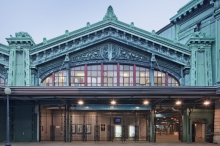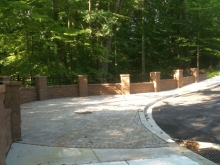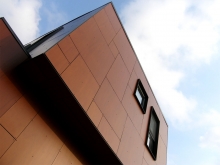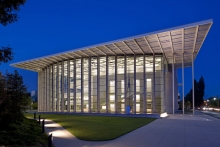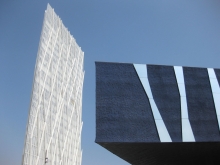- Error
{Re}habitat
Learn how adaptive reuse and upcycling can add hip design to your home, apartment, or yard with the Go Green channel's {Re}habitat series. Follow host Rachael Ranney as she shows you how to repurpose salvaged and found materials, adding fun and function to your space without breaking your budget.

STV Group renovates a 1907 transportation hub in Hoboken, New Jersey, and puts ferry service back in place after an almost 45-year hiatus.
For a century, railroads dominated trade and travel in the United States. Train station architecture developed along with the rail industry itself, and in the early 1900s, every major city was building an ornate hub to call its own. Perhaps the most iconic – and one of the most short-lived – stations was New York City’s Pennsylvania Station. Built in 1910, much of the original Beaux Arts structure, which covered almost 7 acres, was demolished in 1963 to make way for Madison Square Garden and the rest of Penn Plaza. The demolition of the above-ground elements of NYC's Penn Station galvanized preservationists to save many historic stations.
Installing solar panels is becoming more feasible as various financial incentives become available. Jeff Wilson breaks it down into hard numbers to give an idea of what’s really involved with "going solar."
When my family decided to streamline our energy use at home, we first tackled our efficiency problems with a Deep Energy Retrofit. This effort included air-sealing and insulating the building envelope and replacing all of the windows and doors. Once we had our house sealed up tight, we added an Energy Recovery Ventilator to keep indoor air fresh while keeping the energy we use to heat and cool that air inside the house, where it belongs. Only after we completely exhausted energy efficiency measures did we decide to have a 4-kW photovoltaic solar array installed.
Case Study: Water Quality Retrofit and Retaining Wall Remediation
Written by Andrew Kimos Thu Apr 05 2012The City of Takoma Park, Maryland, needed to replace a failing retaining wall that supports a roadway in a small residential development. The Linden Avenue site is directly adjacent to Sligo Creek, which is a tributary of Anacostia Creek, a river undergoing a significant restoration effort. T. E. Scott & Associates, Inc., designed a replacement for the failing retaining wall infrastructure, created a pocket park for the local residents, and provided water quality treatment for the unmanaged watershed. This combination of aesthetic and environmental improvements adds value to the project. We’ll look at some stormwater flow design calculations, a storm water flow splitter, an urban modular wetland unit, a step/plunge pool, and an interesting retaining wall design.
Architecture in New York City draws upon the talents of many international designers, and an exhibition at the German Consulate General held in March celebrated the unique contributions of German architects practicing in New York.
On March 1 – March 23, 2012, the German Consulate General in New York featured an exhibition called Made in USA – German Architects in New York. The exhibition featured the work of seven architects from Germany who are now based in New York. When it comes to design culture, there is a is a long history of exchange and interrelationship between the United States and Germany, and, as a curatorial statement for the exhibition states, “it is within this historic trajectory that this exhibition wants to invite a fresh look on contemporary practice in New York City.”
Valley Performing Arts Center by HGA Architects and Engineers
Written by Murrye Bernard Tue Apr 03 2012A world-class performing arts center harmonizes between town and gown, technology and energy-efficiency.
Located in Southern California’s San Fernando Valley, California State University’s Northridge campus (CSUN) is home to a new $125 million, 166,000-square-foot performing arts center. The Valley Performing Arts Center, certified LEED Gold, was designed by Minneapolis-based HGA Architects and Engineers, specialists in this facility type. The architects faced several challenges in creating a world-class center that incorporates advanced technologies without compromising energy efficiency and also redefines the campus edge while embracing the community.
MulvannyG2 Architecture Designs Self-Sustaining Gashora Girls Academy in Rwanda
Written by Lisa Taylor Minor Mon Apr 02 2012A conversation between two Seattle women sparked action that is now changing the lives of hundreds of young women, as well as a country. Suzanne McGill and Shal Foster founded the Rwanda Girls Inititative and, in partnership with MulvannyG2 Architecture, built a school that is now in its second year of operation and is providing a replicable model for future educational development.
During a marathon training run in 2008, two longtime friends and moms from Seattle began talking about the high-quality educational opportunities available to their children simply because they were born in the United States. The conversation eventually led to a discussion about Africa, a continent where only 13% of young women achieve secondary education due to poverty, lack of opportunity, and obstacles such as household chores and safety concerns. Suzanne McGill and Shal Foster began to wonder: What can we do to make a difference and help to provide educational opportunities for these young African women?
BRB Architects’ design for a new campus center at Molloy College is representative of a larger trend in campus planning: the shift from a commuter-only campus to a 24/7 community.
A commuter college is a college in which most students do not live in dormitories but commute from homes nearby. Community colleges are a common type of commuter college, but many private and smaller colleges and universities also fall into this category. In the past, students of commuter colleges have been present on campus only briefly as they attended classes; they would go elsewhere else to eat, lounge, study, and socialize. Now the atmosphere of many commuter colleges mirrors that of a more traditional college or university environment, where students do not just go to college to attend class but may meet with other students on campus for collaborative projects or simply for recreational purposes. As students begin to spend more time on campus and academic and social lives become increasingly integrated, the need for structural changes on many campuses has become more apparent.
Beset by problems early on, Herzog and de Meuron's Barcelona Forum building has become an admired work of architecture as well as a destination spot, situated as it is next to a busy convention area.
Let’s face it – it’s not easy to stand out architecturally in Barcelona. The city’s architecture portfolio includes some of the most diverse and historical architectural projects in the world. Antoni Gaudí’s exquisite creations, like the Sagrada Família, Casa Batlló, and Casa Milà, have firmly established Barcelona’s reputation as an architectural haven. However, it’s not all Modernisme and Gothic revival in this Mediterranean coastal city. In fact, Barcelona’s 21st century architecture has been making its mark on the city’s impressive architectural scene for years.
